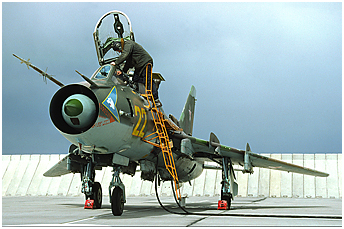
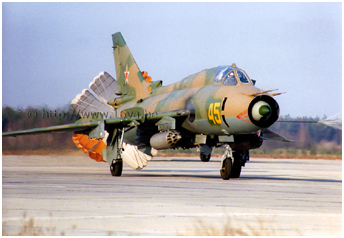 Improving the Su-17M3 already began in 1977. The first prototype of the Article S-54, the future Su-17M4 "Fitter-K" was ready in 1980. In total, three aircraft were modified from Su-17M3 airframes.
Mass production began in 1980, with 265 examples manufactured until 1985, and a second series of 30 aircraft was built in 1987-88. In total, 2783 Su-17 of all versions were assembled at Komsomol'sk-on-Amure.
It was originally planned to mount the Kayra navigation and attack system that already equipped the MiG-27K on the Su-17M4. But it was a simpler complex designated PrNK-54 that was preferred. Previously, it was only possible to use one type of weapon per firing pass (cannons, rockets, bombs, etc.) due to the different ballistic characteristics specific to each weapon. On the Su-17M3, switching from one weapon to another was possible in manual mode, which however required readjusting the aiming point each time. The problem was solved with the Su-17M4 thanks to the SUO-54 weapon control system and its Orbita-20-22 digital computer that made possible the simultaneous use of two types of weapons.
Improving the Su-17M3 already began in 1977. The first prototype of the Article S-54, the future Su-17M4 "Fitter-K" was ready in 1980. In total, three aircraft were modified from Su-17M3 airframes.
Mass production began in 1980, with 265 examples manufactured until 1985, and a second series of 30 aircraft was built in 1987-88. In total, 2783 Su-17 of all versions were assembled at Komsomol'sk-on-Amure.
It was originally planned to mount the Kayra navigation and attack system that already equipped the MiG-27K on the Su-17M4. But it was a simpler complex designated PrNK-54 that was preferred. Previously, it was only possible to use one type of weapon per firing pass (cannons, rockets, bombs, etc.) due to the different ballistic characteristics specific to each weapon. On the Su-17M3, switching from one weapon to another was possible in manual mode, which however required readjusting the aiming point each time. The problem was solved with the Su-17M4 thanks to the SUO-54 weapon control system and its Orbita-20-22 digital computer that made possible the simultaneous use of two types of weapons.
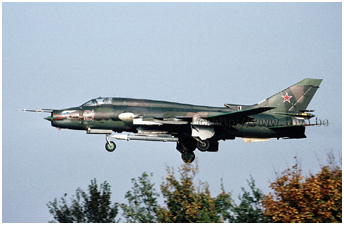
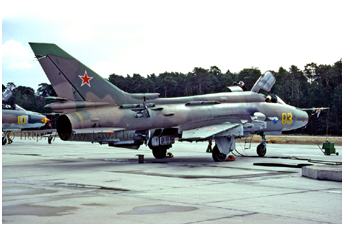 In order to free up space in the fuselage and reduce weight, the movable nose cone of earlier Su-17 versions was made fixed. As a result, the maximum speed decreased from Mach 2 for the Su-17M3 to Mach 1.7 for the Su-17M4. However, it was not a real handicap given the flight profile of fighter-bombers, although the fuel consumption was significantly higher at high altitude.
The modernized Klen-PS laser rangefinder and target designator of the "Fitter-K" had its designation changed to Klen-54, while a VG-17 optical sensor was added. The latter was associated with an IT-23M display screen mounted top right on the instrument panel.
In doing so, the use of TV-guided weapons such as the Kh-29T missile became possible. The latter was entirely autonomous once fired, leaving the pilot free to fly away from the target.
All the Su-17M3 weapons were kept, except the Kh-23/M and the Kh-28 missiles that were no longer used.
The Su-17M3 pilot had to continually keep the laser beam on the target using a joystick button mounted on the control stick to direct a laser-guided missile. On the other hand, the beam was automatically kept on the target by the PrNK of the Su-17M4 once the latter had been designated and locked on by the missile. Unlike other aircraft such as the Su-25 whose target could be designated by a laser illuminator on the ground, the PrNK on the Su-17M4 could only recognize a target illuminated by a Klen-54, thereby rejecting interference from another adversary system.
In order to free up space in the fuselage and reduce weight, the movable nose cone of earlier Su-17 versions was made fixed. As a result, the maximum speed decreased from Mach 2 for the Su-17M3 to Mach 1.7 for the Su-17M4. However, it was not a real handicap given the flight profile of fighter-bombers, although the fuel consumption was significantly higher at high altitude.
The modernized Klen-PS laser rangefinder and target designator of the "Fitter-K" had its designation changed to Klen-54, while a VG-17 optical sensor was added. The latter was associated with an IT-23M display screen mounted top right on the instrument panel.
In doing so, the use of TV-guided weapons such as the Kh-29T missile became possible. The latter was entirely autonomous once fired, leaving the pilot free to fly away from the target.
All the Su-17M3 weapons were kept, except the Kh-23/M and the Kh-28 missiles that were no longer used.
The Su-17M3 pilot had to continually keep the laser beam on the target using a joystick button mounted on the control stick to direct a laser-guided missile. On the other hand, the beam was automatically kept on the target by the PrNK of the Su-17M4 once the latter had been designated and locked on by the missile. Unlike other aircraft such as the Su-25 whose target could be designated by a laser illuminator on the ground, the PrNK on the Su-17M4 could only recognize a target illuminated by a Klen-54, thereby rejecting interference from another adversary system.
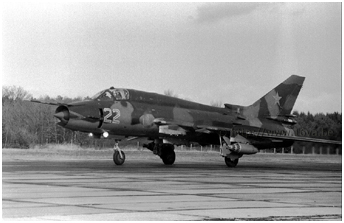
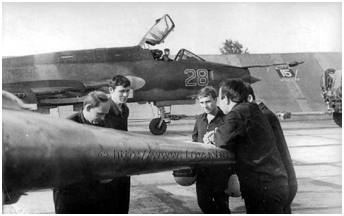 When Kh-25MP, Kh-27PS or Kh-58U anti-radar missiles were carried, in addition to a V'yuga pod (designated V'yuga-54 in a technical manual) bolted under the belly, a Luch light display used to show the range to the target, the lateral separtion or when the target was locked on, was mounted on a support attached to the IT-23M screen. Often, it was not dismounted and the aircraft then became a privileged vector for anti-radar missions. Four SPPU-22 cannon pods could be used simultaneously, two forward-firing units mounted under the wings and two rear-firing under the fuselage. In this case, the pilot had to remember to raise the guns on landing as warned by a signal... The "Fitters" were also likely to carry AAP-500 (> Link) containers attached under the outer wing hardpoints that were designed to spread a smoke screen on the battlefield. The fuel capacity was reduced to accommodate all the equipment, i.e. 4540 instead of 4870 liters. A heat exchanger whose air intake was located at the base of the vertical fin was added to cool the electronics, thus forming the unique silhouette of the Su-17M4.
When Kh-25MP, Kh-27PS or Kh-58U anti-radar missiles were carried, in addition to a V'yuga pod (designated V'yuga-54 in a technical manual) bolted under the belly, a Luch light display used to show the range to the target, the lateral separtion or when the target was locked on, was mounted on a support attached to the IT-23M screen. Often, it was not dismounted and the aircraft then became a privileged vector for anti-radar missions. Four SPPU-22 cannon pods could be used simultaneously, two forward-firing units mounted under the wings and two rear-firing under the fuselage. In this case, the pilot had to remember to raise the guns on landing as warned by a signal... The "Fitters" were also likely to carry AAP-500 (> Link) containers attached under the outer wing hardpoints that were designed to spread a smoke screen on the battlefield. The fuel capacity was reduced to accommodate all the equipment, i.e. 4540 instead of 4870 liters. A heat exchanger whose air intake was located at the base of the vertical fin was added to cool the electronics, thus forming the unique silhouette of the Su-17M4.
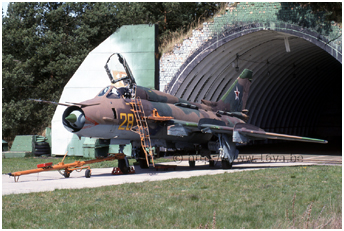
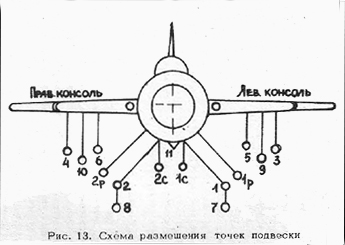 The "Fitter-K" was the first aircraft equipped with a new system called Uvod (deviation, avoidance) intended to prevent the aircraft from flying over the area of fragments caused by the explosion of its own weapons -
some Su-17M3 had armor plates added under the fuselage to protect sensitive areas. The plane automatically deviated from its trajectory if the pilot ignored the warnings of the system that took into account the effective zone of weapons use and the maneuverability of the aircraft.
In addition to the two 50mm KDS-23 flare launchers mounted into the fuselage and the ASO-2VM blocs that could be attached to it (two on each side), four other ASO-2V units were often fixed under the fuselage, behind the jet exhaust nozzle. This last option was also possible on the Su-17M3.
The AKS-5 firing camera located in the leading edge of the fixed part of the right wing was no longer mounted from the 13th series aircraft, while the SSh-45 camera that took pictures through the HUD was kept. However, it was now possible to mount an FKP-58 pod under the right pylon originally intended for an R-60 missile. In addition to the firing images, data on range and aiming were recorded. In the case of the Kh-29T missiles, the TV signal was recorded as were the radio communications. The debriefing could be done on a TV screen or directly on the IT-23M screen. The FKP-58 used by the Su-17M4 had a slightly different shape from that used by the MiG-27.
The "Fitter-K" was the first aircraft equipped with a new system called Uvod (deviation, avoidance) intended to prevent the aircraft from flying over the area of fragments caused by the explosion of its own weapons -
some Su-17M3 had armor plates added under the fuselage to protect sensitive areas. The plane automatically deviated from its trajectory if the pilot ignored the warnings of the system that took into account the effective zone of weapons use and the maneuverability of the aircraft.
In addition to the two 50mm KDS-23 flare launchers mounted into the fuselage and the ASO-2VM blocs that could be attached to it (two on each side), four other ASO-2V units were often fixed under the fuselage, behind the jet exhaust nozzle. This last option was also possible on the Su-17M3.
The AKS-5 firing camera located in the leading edge of the fixed part of the right wing was no longer mounted from the 13th series aircraft, while the SSh-45 camera that took pictures through the HUD was kept. However, it was now possible to mount an FKP-58 pod under the right pylon originally intended for an R-60 missile. In addition to the firing images, data on range and aiming were recorded. In the case of the Kh-29T missiles, the TV signal was recorded as were the radio communications. The debriefing could be done on a TV screen or directly on the IT-23M screen. The FKP-58 used by the Su-17M4 had a slightly different shape from that used by the MiG-27.
| ORBAT 1976 - 1994 |
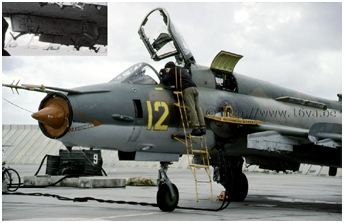
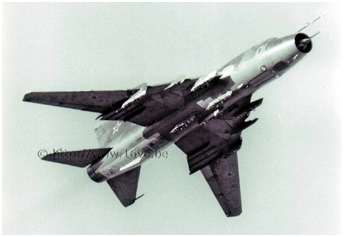 The Su-17M4 retained the same nuclear capabilities as the Su-17M3. Several aircraft were observed until 1993 in a nuclear configuration where a single BD3-56FNM pylon was mounted asymmetrically on the left side of the fuselage (hardpoint 1s), while two standard BD3-57MT pylons remained mounted on the right side (hardpoints 2 and 8). The East German Air Force, which used the export version Su-22M4 (S-54K) within the JBG-77 and the MFG-28, both based at Laage, could also carry out special missions, as well as the other Warsaw Pact allies using the same type of aircraft.
The Su-17M4 retained the same nuclear capabilities as the Su-17M3. Several aircraft were observed until 1993 in a nuclear configuration where a single BD3-56FNM pylon was mounted asymmetrically on the left side of the fuselage (hardpoint 1s), while two standard BD3-57MT pylons remained mounted on the right side (hardpoints 2 and 8). The East German Air Force, which used the export version Su-22M4 (S-54K) within the JBG-77 and the MFG-28, both based at Laage, could also carry out special missions, as well as the other Warsaw Pact allies using the same type of aircraft.
| Fighter-bomber combat training course in 1990 |
| To successfully complete the fighter-bomber combat training course, a pilot first class had to complete 20 firing passes, including at least 10 with unguided rockets, 20 bombing runs including 7 at dusk or at night and 4 in navigation mode (automatic), 5 simulated and 2 real firings of air-to-ground missiles as well as 3 simulated firings of anti-radar missiles. Fifteen flights were also to be carried out evading anti-aircraft defenses, 15 in air combat, 8 reconnaissance flights and 3 free fighter missions (search and attack of ground targets). |
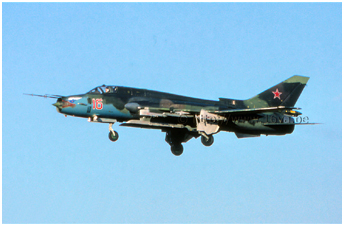
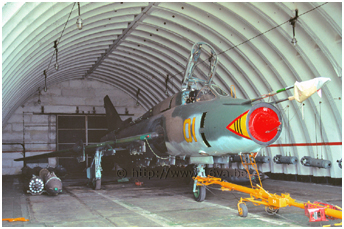 The USMLM confirmed the presence of the first Su-17M4 in Neuruppin in July 1982. These aircraft of the 730.APIB were flown to the GDR disassembled in crates by VTA An-22.
At that time, the first squadron was already almost re-equipped, while the other two squadrons were still flying the Su-17M. In the spring of 1984, the regiment served as a showcase for LSK/LV pilots who were preparing to receive new Su-22M4 (1). For a month, the planes were studied on the ground, and they carried out flight demonstrations as well as attacks on the Wittstock firing range with different weapons and fired nine Kh-25 and two Kh-29 missiles.
Still within the 730.APIB, an aircraft would have been adapted to carry a KKR reconnaissance pod for experimental purposes. The idea was to allow fighter-bomber units to carry out occasional reconnaissance missions. However, this remained without follow-up since reconnaissance remained reserved for specialized units whose personnel had undergone specific training, although as we saw in the section devoted to the MiG-27, reconnaissance pods did indeed exist at least within the 296.APIB.
In the summer of 1986, the regiment from Neuruppin was tasked by the commander of the GSFG to check the readiness of the local anti-aircraft defense forces. Su-17 formations flew over the border areas at low altitude, taking the defenders by surprise. A similar task fell to the regiment in June 1988. It was responsible for covering the south of the GDR with a penetration into Czechoslovakia as far as Prague, then fly up north through Poland and finally come back to Neuruppin from the north. Only the pilots of the LSK/LV would have managed to credibly face the threat.
The USMLM confirmed the presence of the first Su-17M4 in Neuruppin in July 1982. These aircraft of the 730.APIB were flown to the GDR disassembled in crates by VTA An-22.
At that time, the first squadron was already almost re-equipped, while the other two squadrons were still flying the Su-17M. In the spring of 1984, the regiment served as a showcase for LSK/LV pilots who were preparing to receive new Su-22M4 (1). For a month, the planes were studied on the ground, and they carried out flight demonstrations as well as attacks on the Wittstock firing range with different weapons and fired nine Kh-25 and two Kh-29 missiles.
Still within the 730.APIB, an aircraft would have been adapted to carry a KKR reconnaissance pod for experimental purposes. The idea was to allow fighter-bomber units to carry out occasional reconnaissance missions. However, this remained without follow-up since reconnaissance remained reserved for specialized units whose personnel had undergone specific training, although as we saw in the section devoted to the MiG-27, reconnaissance pods did indeed exist at least within the 296.APIB.
In the summer of 1986, the regiment from Neuruppin was tasked by the commander of the GSFG to check the readiness of the local anti-aircraft defense forces. Su-17 formations flew over the border areas at low altitude, taking the defenders by surprise. A similar task fell to the regiment in June 1988. It was responsible for covering the south of the GDR with a penetration into Czechoslovakia as far as Prague, then fly up north through Poland and finally come back to Neuruppin from the north. Only the pilots of the LSK/LV would have managed to credibly face the threat.
| The 20.GvAPIB and its Commander |
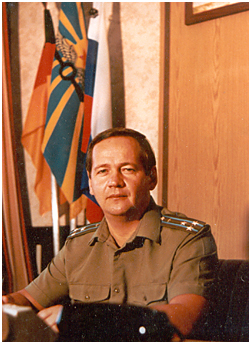 Le colonel de la garde Valeri Tamarovski, commandant du 20.GvAPIB entre 1989 et début 1993. © 20.GvAPIB.
Le colonel de la garde Valeri Tamarovski, commandant du 20.GvAPIB entre 1989 et début 1993. © 20.GvAPIB.
Guards Colonel Valeri Tamarovski, commander of the 20.GvAPIB from 1989 to early 1993. © 20.GvAPIB.
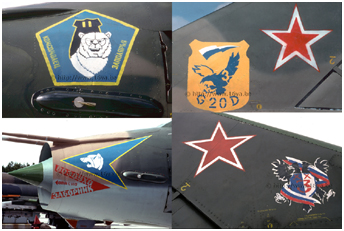 Deliveries of Su-17M4 in Gross Dölln began in 1989 with aircraft coming from units based in the Far East, previously overhauled at the Baranovichi ARZ.
Su-17M3 were probably still active within the 3.AE during the summer of 1990 (see aircraft n°32 and 40 illustrated on the previous page).
Already in 1989, a few Su-17M4 from Neuruppin were identified at Gross Dölln, replacing some Su-17M3. They were probably transferred from the 730.APIB when the standard structure of aviation regiments was reduced from 40+ aircraft to around 32. Also, other aircraft from the 730.APIB further replaced the remaining Su-17M3 of the 20.GvAPIB when they left Neuruppin in 1990 and 1991.
Deliveries of Su-17M4 in Gross Dölln began in 1989 with aircraft coming from units based in the Far East, previously overhauled at the Baranovichi ARZ.
Su-17M3 were probably still active within the 3.AE during the summer of 1990 (see aircraft n°32 and 40 illustrated on the previous page).
Already in 1989, a few Su-17M4 from Neuruppin were identified at Gross Dölln, replacing some Su-17M3. They were probably transferred from the 730.APIB when the standard structure of aviation regiments was reduced from 40+ aircraft to around 32. Also, other aircraft from the 730.APIB further replaced the remaining Su-17M3 of the 20.GvAPIB when they left Neuruppin in 1990 and 1991.
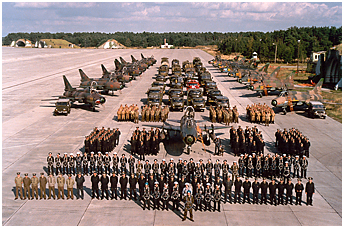 The 20.GvAPIB began to stand out from the other regiments of the 16.VA beginning in 1991.
Probably taking advantage of the disciplinary relaxations that occurred at this time and especially of the esprit de corps instilled by its commander, the very charismatic Colonel Valeri Tamarovski,
nose art and regimental or squadron emblems were painted on the aircraft! Among the first, we can pin a whale (n°02), a centaur quickly replaced by a shark's mouth (n°27), a small rhinoceros replaced by a tiger's head (n°88), a griffin (n°84) or, more "official", the insignias of the second and third squadrons, a polar bear's head on a blue pentagon and a blue eagle on an orange background, respectively. The latter, undoubtedly considered too close to the colors of the new independent Ukraine, was transformed in 1993 into a Tsarist double-headed eagle draped in the white, blue, and red tricolour.
The 20.GvAPIB began to stand out from the other regiments of the 16.VA beginning in 1991.
Probably taking advantage of the disciplinary relaxations that occurred at this time and especially of the esprit de corps instilled by its commander, the very charismatic Colonel Valeri Tamarovski,
nose art and regimental or squadron emblems were painted on the aircraft! Among the first, we can pin a whale (n°02), a centaur quickly replaced by a shark's mouth (n°27), a small rhinoceros replaced by a tiger's head (n°88), a griffin (n°84) or, more "official", the insignias of the second and third squadrons, a polar bear's head on a blue pentagon and a blue eagle on an orange background, respectively. The latter, undoubtedly considered too close to the colors of the new independent Ukraine, was transformed in 1993 into a Tsarist double-headed eagle draped in the white, blue, and red tricolour.
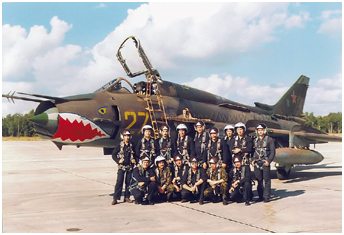
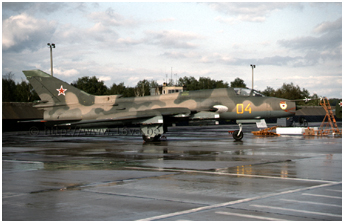 The 2.AE emblem quickly was transformed into a bear's head against a blue chevron; as for the bat painted on the nose of aircraft n°05 undoubtedly inspired by similar decorations worn by Su-17 that flew in Afghanistan, it still remains to be proven that it was possibly the emblem of the first squadron to the extent where, to our knowledge, only one aircraft bore this emblem.
Some officers did not appreciate this type of originality because the wearing of these badges was, it seems, quickly banned by express order from higher authorities.
Fortunately for the aerophiles, this measure was only partially implemented and, at the time of their departure for the CIS, many of the 20.GvAPIB aircraft were still decorated with various markings.
The 2.AE emblem quickly was transformed into a bear's head against a blue chevron; as for the bat painted on the nose of aircraft n°05 undoubtedly inspired by similar decorations worn by Su-17 that flew in Afghanistan, it still remains to be proven that it was possibly the emblem of the first squadron to the extent where, to our knowledge, only one aircraft bore this emblem.
Some officers did not appreciate this type of originality because the wearing of these badges was, it seems, quickly banned by express order from higher authorities.
Fortunately for the aerophiles, this measure was only partially implemented and, at the time of their departure for the CIS, many of the 20.GvAPIB aircraft were still decorated with various markings.
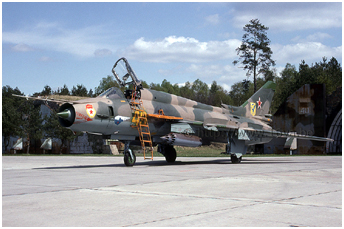
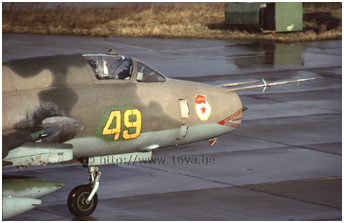 It was logical, in this context, that the regiment would end up proudly displaying its Guards emblem. Aircraft n°04 stood out in this way decorated on the static display of the small open day organized in Altenburg on February 23, 1992 on the occasion of the festivities of the traditional Russian Armed Forces Day as well as at the open days in Finow and Grossenhain. However, with the exception of this aircraft, only the aircraft of the 3.AE received this decoration although without the "CCCP" markings. Furthermore, the appearance of these different emblems was not limited to airplanes. Thus, in particular a small enameled regimental coat of arms for the pilots, a fabric badge bearing the name of the aerodrome and various pennants were created. Finally, a project for fabric symbols designating personnel specialties was submitted to the General Staff and refused.
It was logical, in this context, that the regiment would end up proudly displaying its Guards emblem. Aircraft n°04 stood out in this way decorated on the static display of the small open day organized in Altenburg on February 23, 1992 on the occasion of the festivities of the traditional Russian Armed Forces Day as well as at the open days in Finow and Grossenhain. However, with the exception of this aircraft, only the aircraft of the 3.AE received this decoration although without the "CCCP" markings. Furthermore, the appearance of these different emblems was not limited to airplanes. Thus, in particular a small enameled regimental coat of arms for the pilots, a fabric badge bearing the name of the aerodrome and various pennants were created. Finally, a project for fabric symbols designating personnel specialties was submitted to the General Staff and refused.
But Guards Colonel Tamarovski's regiment also stood out at the piloting and operational levels. Thus, from October 1990, the pilots began to practice take off and landing in a formation of four aircraft (see the video links at the bottom of the page entitled "The 20.GvAPIB and its Commander" provided in the above link). It is true that the 80 meters wide main runway at Gross Dölln lent itself particularly well to this practice that was reserved for the most experienced pilots.
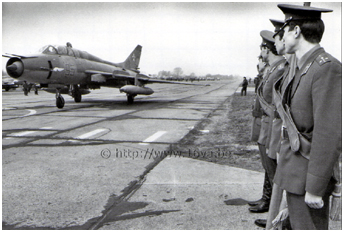
 1991 also sounded the death knell for the 730.APIB that would owe German and foreign television a little notoriety on the occasion of its departure. Located in the immediate suburbs of the city to the great inconvenience of its neighbours, this airfield was the source of a real permanent hearing nightmare for the Neuruppiner.
The latter was to end on April 26, 1991 when the last 14 airplanes of the regiment (2) flew for a short stopover at Gross Dölln where they were welcomed with pomp and circumstance, the planes taxiing in front of the 20.GvAPIB personnel in full uniform, lined up along the taxiways. They left Germany two days later on April 28 - leaving behind them at least two identified aircraft (n°20 then recoded 24 and n°49) taken on charge by the 20.GvAPIB - for Migalovo (Tver') before finally joining the 4215.BRAT in Chebenki, east of Orenburg, to be stored there before finally being scrapped. The regiment was disbanded on June 20, 1991.
1991 also sounded the death knell for the 730.APIB that would owe German and foreign television a little notoriety on the occasion of its departure. Located in the immediate suburbs of the city to the great inconvenience of its neighbours, this airfield was the source of a real permanent hearing nightmare for the Neuruppiner.
The latter was to end on April 26, 1991 when the last 14 airplanes of the regiment (2) flew for a short stopover at Gross Dölln where they were welcomed with pomp and circumstance, the planes taxiing in front of the 20.GvAPIB personnel in full uniform, lined up along the taxiways. They left Germany two days later on April 28 - leaving behind them at least two identified aircraft (n°20 then recoded 24 and n°49) taken on charge by the 20.GvAPIB - for Migalovo (Tver') before finally joining the 4215.BRAT in Chebenki, east of Orenburg, to be stored there before finally being scrapped. The regiment was disbanded on June 20, 1991.
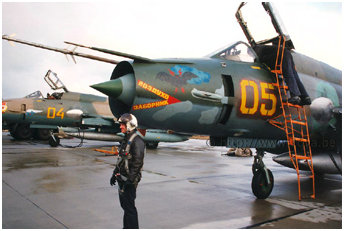
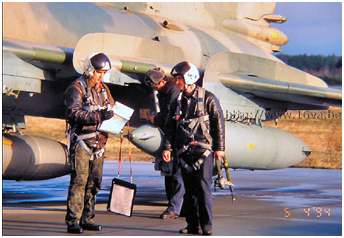 The 20.GvAPIB would be among the last combat aircraft regiments of the 16.VA to leave German territory in the spring of 1994. As of March 22, four aircraft were repatriated and, on the morning of April 5, the last thirty-three Gross Dölln "Fitter" headed for Taganrog on the shores of the Sea of Azov where they replaced the Su-17M3 of the 963.APIB. However, this regiment was quickly disbanded and the old aircraft of the 20.GvAPIB went to Chebenki to be stored before ending up as scrap metal (planes of the 2. and 3.AE were identified there > Photos).
The 20.GvAPIB would be among the last combat aircraft regiments of the 16.VA to leave German territory in the spring of 1994. As of March 22, four aircraft were repatriated and, on the morning of April 5, the last thirty-three Gross Dölln "Fitter" headed for Taganrog on the shores of the Sea of Azov where they replaced the Su-17M3 of the 963.APIB. However, this regiment was quickly disbanded and the old aircraft of the 20.GvAPIB went to Chebenki to be stored before ending up as scrap metal (planes of the 2. and 3.AE were identified there > Photos).
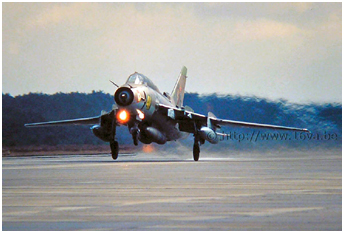
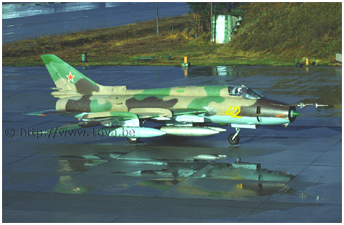 But it was not yet completely the end for the regiment and its personnel who went to Kamenka near Penza (some 550 kilometers east of Moscow) to be equipped with Su-24. Accompanying them were their families, eager to come and settle in the new housing project built in Kamenka by a German-Bulgarian consortium, thanks to financing provided by the Federal Republic of Germany, a return to the country in rather privileged conditions compared to often precarious housing conditions in which several units found themselves upon their return from Germany. Reassigned, as part of the restructuring of the Russian Federation Air Forces to the new 16th Composite Air Corps at Kubinka (a direct descendant of the 16.VA which was finally reestablished as such on February 1, 2002), the new 20.GvBAP was subordinate to the 105.SAD (former 105.ADIB at Grossenhain) whose headquarters was in Voronezh.
In May 1994, the Su-24 "Fencer-C/D" of the 953.BAP from Bobrovichi (Gomel') in Belarus flew to Kamenka where aircraft and personnel joined the ranks of the 20.GvBAP which was finally disbanded on May 1, 1998. If the regiment had ceased to exist, its traditions continued to live for a few more years following the transfer of all its titles and honorary awards to the 899.ShAP of Buturlinovka in 1998. The Su-25 regiment became de facto a Guards unit awarded with the Order of the Red Banner! On November 19, 2009, the 899.GvShAP was disbanded...
But it was not yet completely the end for the regiment and its personnel who went to Kamenka near Penza (some 550 kilometers east of Moscow) to be equipped with Su-24. Accompanying them were their families, eager to come and settle in the new housing project built in Kamenka by a German-Bulgarian consortium, thanks to financing provided by the Federal Republic of Germany, a return to the country in rather privileged conditions compared to often precarious housing conditions in which several units found themselves upon their return from Germany. Reassigned, as part of the restructuring of the Russian Federation Air Forces to the new 16th Composite Air Corps at Kubinka (a direct descendant of the 16.VA which was finally reestablished as such on February 1, 2002), the new 20.GvBAP was subordinate to the 105.SAD (former 105.ADIB at Grossenhain) whose headquarters was in Voronezh.
In May 1994, the Su-24 "Fencer-C/D" of the 953.BAP from Bobrovichi (Gomel') in Belarus flew to Kamenka where aircraft and personnel joined the ranks of the 20.GvBAP which was finally disbanded on May 1, 1998. If the regiment had ceased to exist, its traditions continued to live for a few more years following the transfer of all its titles and honorary awards to the 899.ShAP of Buturlinovka in 1998. The Su-25 regiment became de facto a Guards unit awarded with the Order of the Red Banner! On November 19, 2009, the 899.GvShAP was disbanded...
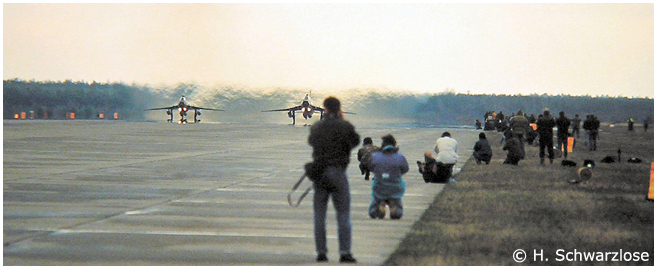
 |
Su-17 PHOTO PAGE |  |
notes
(1)
The first personnel were trained in Krasnodar from May 18 to June 21, 1984.
(2)
The aircraft of Neuruppin were repatriated in several flights. The equivalent of a squadron was transferred to the 20.GvAPIB where they
replaced the regiment's last Su-17M3.
It also was reported that a squadron joined the 274.APIB at Kalinin and another one at Monchegorsk probably in 1990.
 |
Plan du site - Sitemap |  |
